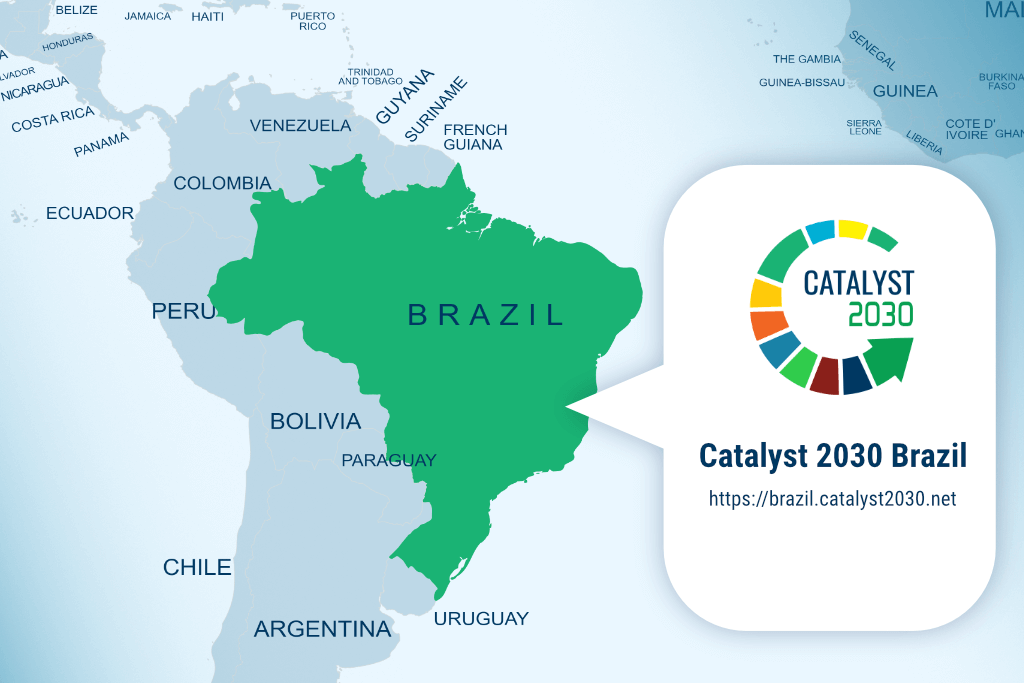Catalyst 2030’s Brazil Chapter has made huge progress on its fundraising strategy and targets over the past year. In conversation with Karolina Bergamo, the Brazil Chapter Coordinator, we have collaborated to share their top tips with you to apply to your own fundraising strategy. Each tip is specific to fundraising for collaborations and chapter work and can be directly applied in your everyday approach to fundraising.
Tip one: use your (and your peers) relationships
Use the relationships and the bridges you already have with potential funders, no matter how strong the connection. The Brazil Chapter has secured donations from two donors with varying degrees of connection: one already had a history of funding and working on projects with the Chair, and another was simply an acquaintance of one of the Chapter members.
In this case, the Chapter acted as a network that members were able to tap into. No matter how strong the connection to a potential funder, you will always have more success when leveraging the power of your network and personal connections. As a movement of social entrepreneurs, your network is often stronger than you may think. And remember, ‘people give to people’, whether it’s their time, expertise, or resources.
Tip two: refine your operating strategy
Build a strong strategy of what your chapter or collaboration hopes to achieve for the coming year. Your strategy should indicate what resources are necessary and what you need to do to accomplish these goals. To facilitate this, the Brazil Chapter had a meeting specifically designed to plan and develop a strategy for 2022 and then created a template for each member to use when planning their collaborations. The sum of this effort was a clearly defined country level strategy and well-documented and defined local level strategies for each collaboration. By gathering this into one centralised plan, the Chapter was able to develop a holistic strategy for the year, which could be used to approach funders for support (see tip four to see how).
Tip Three: start ‘small’
As you will likely know, not many people understand how collaborative systems change works.
For those who are new to the concept, collaborative systems change, it is an approach to mobilise a diverse set of people and organisations to collectively imagine and create positive systems change. It can occur in existing systems, or it can be used to create new, more inclusive systems where they do not otherwise exist. By its very nature, ‘systems change’ initiatives target change at the system level and therefore take time to realise their goals.
In order to demonstrate to funders how collaborative systems change works, the Brazil Chapter created a menu of “tangible and simple” collaborations, for their members to choose from and engage with, that would achieve instant results. This menu included writing articles for local newspapers and journals, drafting policy recommendations, leading local advocacy initiatives or creating resources and tools for social entrepreneurs in the region.
This strategy was hugely successful. Chapter members published four articles in a leading Brazilian newspaper and suggested a series of recommendations to be included in a Bill in the State of Sao Paulo, all of which were accepted. In terms of their fundraising strategy, these tangible and simple collaborations could now provide proof of impact. In our next tip, you’ll see exactly how they were able to leverage this impact to engage funders.
Tip four: create reports and presentations to showcase your work
The Brazil Chapter found that when creating content, it was important to create “something beautiful” and engaging (we call this a case for support). The Chapter’s key focus areas in its publications, bothreports andpresentations, were as follows:
- An overview of Catalyst 2030
- How the Chapter formed
- Who the Chapter members are and their roles
- Showcasing their “tangible and simple” collaborative systems change work (explained in tip three)
- An overview of the events and seminars they organised
- Top level information on their 2022 strategic plan and how they developed it (explained in tip two)
- The ‘ask’, that is, what the funder can invest to support their mission
The Chapter sent this publication to all of the Brazil Chapter members and to prospective and existing funders. These resources highlighted all of the key areas of their mission and work, while providing clear examples of their collaborative impact. This was hugely successful with funders, who were able to see exactly how the Chapter works, how successful members can be, what they are planning to achieve in the coming year and how they, as the funder, can be a part of their work.
Tip five: don’t give up
Of course, this is easy to say, but it is important to not give up. Fundraising includes rejection – that is inevitable. But, each time you formulate your work for a funder, invest time and energy into developing a clear strategy and add another collaborative success to your report or presentation, you are one step closer to securing funding. In the end, all these interconnected parts lay the foundations for your first successful funding application. Rejection does not mean that all is lost. Rather, it means it is time to recalibrate, review strategies and press ahead with collaboration.
For Brazil, it was not easy to raise funds. But, once they received their first grant, the second grant was easier and now they are in the process of securing their third. So remember, success lies ahead!

